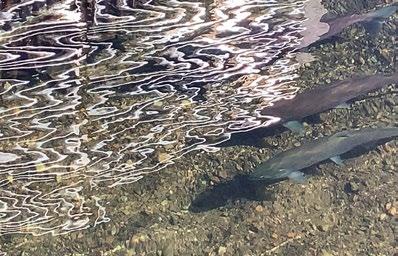
26 minute read
Successful Hunts & Fishing by Tahltans
TAHLTAN LAKE SOCKEYE ADULT ENUMERATION
Above: First sockeye salmon arriving at the Tahltan Lake weir – 9:40am July 22, 2020.
TAHLTAN LAKE WEIR ENUMERATION RESULTS
SOCKEYE SPAWNERS 11,158 / MANAGEMENT GOAL 24,000 This project is typically conducted jointly with DFO and Tahltan staff but was modified to adhere to COVID-19 protocols and ensure staff safety in the field.
The TCGFD field crew mobilized to Tahltan Lake on July 7. Construction of the adult weir was completed and fish tight on July 9 in preparation for the arrival of the returning sockeye spawners. Michael Nole and Kyle Inkster patiently awaited the arrival of the first sockeye, which were significantly delayed, not arriving at the lake until July 22. The remainder of the run was also delayed and did not show the run strength indicated by the in-season adjusted forecasts, based on catches in the Lower River fisheries.
The weir was dismantled on September 11, with a total of 11,158 sockeye spawners counted. Although
this number is below the Escapement Goal Range of 18,000-30,000 and management target of 24,000 spawners, long term survival data does not indicate
major concerns for the 2025 return year. We will keep you posted on the winter technical discussions and any indications otherwise.
CATCH MONITORING & REPORTING
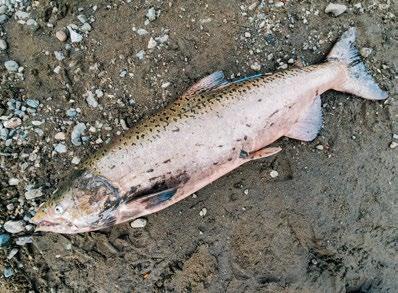
Above: The first Chinook harvested in FSC fishery had a spaghetti tag applied to its dorsal fin. This tag was applied as part of the Lower Stikine Chinook Adult Tagging project. The Catch Monitor program based in Telegraph Creek saw Noreen McLean return to fulfill the duties associated with the position. She was responsible for handing out fishing and transport permits, collecting weekly catches from Members, and reporting to the Fisheries Manager.
The total number of salmon harvested in the FSC Fishery was 5,423 Sockeye, 389 Chinook, 642 Jacks (small chinook) and 2 Coho. This project was funded by AFS/PST Implementation Funds.
CATCH MONITORING & REPORTING RESULTS
5,423 642
SOCKEYE JACKS
389 2
CHINOOK COHO
STIKINE STOCK SEPARATION
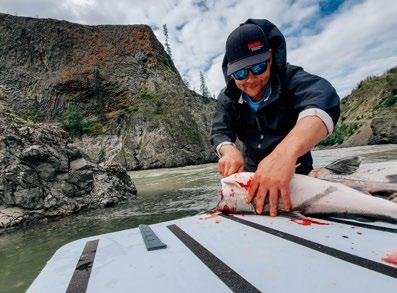
The Stikine Stock Separation program ran from June 23 to August 23. Its purpose is to sample a portion of the Sockeye run to determine the composition. The run is comprised of different components, Lake spawners (Tahltan Lake) and River spawners (Tahltan River), which are further categorized as enhanced versus wild.
The samplers for 2020 were Drew Inkster, Brendan Joseph, and Raina Feldman. They collected biological samples from the catches in the FSC fishery for analysis to determine the origin of the fish, which helps in the overall management of salmon resources in the Stikine watershed. The samplers were able to sample a total of 513 Sockeye and 115 Chinook. They also sampled a lot later into August, usually they pack up the first week. This is due to a variation in the run timing. The salmon were later this year, which seems to be a trend over the last few seasons. It is something to be mindful of for future food fishing efforts. This project was funded by AFS/PST Implementation Funds.
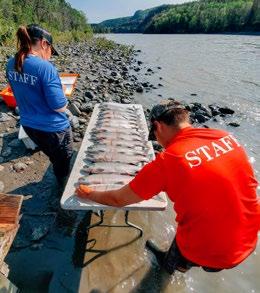
STIKINE STOCK SEPARATION PROGRAM SAMPLING RESULTS
513 SOCKEYE 115
CHINOOK Top-left: Brendan sampling. Top-right: Brendan and Raina sampling.
The Tahltan River Chinook Enumeration Feasibility Study is a new project funded under the AFS/PST Implementation Fund. It was supposed to have feet on the ground this year, but due to COVID-19 the project was modified to facility upgrades (a new outhouse and two bedrooms added to the Tahltan fisheries cabin) and equipment purchasing. This project’s aim is to get a much more accurate count of Chinook salmon entering the Tahltan watershed using Sonar technology. Sonar technology is very appealing because it eliminates the need to handle the fish. Reducing handling supports better survival rates.
The two potential sites will be at the Tahltan River bridge crossing and the Cannery.
Both the TCGFD and DFO managers are anxious to get this project running in the 2021 field season.
STIKINE RIVER AERIAL SURVEYS
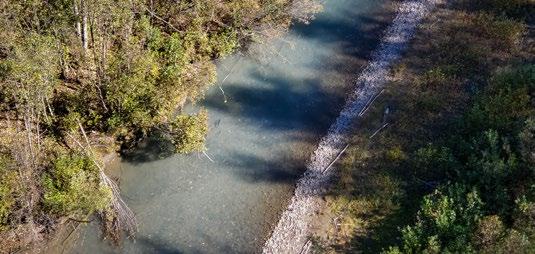
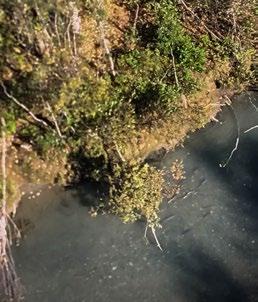
Top & Above: Sockeye Salmon observed and counted at Verrett river during aerial survey. The 2020 sockeye aerial survey was conducted September 15th with Cheri and Kerry as observers. Tundra Helicopters was chartered for the flight.
In general, survey conditions were exceptional–blue sky and clear water conditions–but overall a poor showing of sockeye spawners at the Mainstem index sites was concerning. A total of 172 sockeye were counted.
The Stikine Coho aerial survey is scheduled for November 3, 2020. Tundra Helicopters has been chartered again, and Kerry and Cheri will conduct the survey of spawners observed. The index sites to be flown include Scud River, Porcupine River, Katete River (main and west arm), Verrett River, Craig River and Verrett slough.
These flights are funded through the AFS Contribution Agreement.
TAHLTAN RIVER SLIDE
The 2020 fishing season saw a return of close-toaverage water levels, which persisted through most of the season.
Although this was not the greatest for fishing efforts, it was a blessing to the fish, helping with the slide at Tahltan, as well as the recent migration issues arising from the low flows at Decheeka Falls.
The higher water levels this field season resulted in the natural flushing out of ruble and fine debris from the prior blasting efforts, to the point where it appears it has become a non-issue. This summer, field work was done by Golder Associates to assess the current state of the slide. They were able to use a drone to gather some measurements and take great pictures. One of Golder’s early observations was the drastic decrease in vertical distance the fish need to pass or jump the slide, which went from approximately 9 ft to approximately 2 ft. (see Figure 1). The salmon are no longer jumping at the site but are now able to swim right past it. This was confirmed by visual observations and the presence of fish at weir sites further upriver. Although the final report from Golder is pending, they provided some preliminary recommendations.
TCGFD has had early discussions with DFO about next steps, given the findings of the recent site evaluation. The first option discussed is to do nothing and let things carry on as they are now. The reasoning is that any further work could make things worse by bringing down more material, and the site is a very dangerous and unstable place to work.
The other option is pre-emptive removal of some boulders perched above the small inlet being created by a rock pushing water to make a back eddy. This is visible in Figure 2. The red circle is the inlet, and the green is the potential problem boulders. The rationale is that the small eddy will eat away at the material and eventually those boulders could fall into the river, which may or may not cause a problem. Golder explained the issue (or fact of uncertainty) is that the size of the boulders is not known because they are not fully exposed.
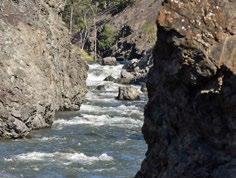
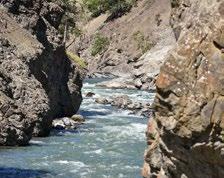
Figure 1.
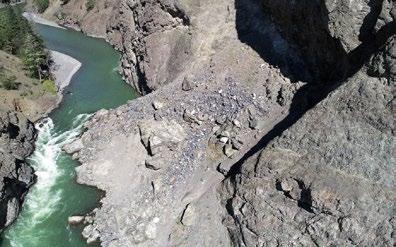
Figure 2.
This is an issue for two reasons:
1 . the rocks could be much larger, making the scope of work difficult to fully understand; 2 . the subsequent removal of the boulders could cause more issues.
The first and preferred approach discussed was not doing any work, but having a plan ready in case an issue should arise. This will be subject to further discussion once the final report is available for review.
2020 ESCAPEMENTS
The following table shows the bilaterally agreed upon escapement goals for Stikine Chinook, Sockeye and Coho salmon, as set out in the US/Canada Pacific Salmon Treaty. The process for reviewing and updating these escapement goals has begun while the Sockeye EG review has already started.
Watershed Species Area Management Target (MSY*) Management Target Range Comments
Stikine Chinook Stikine 28,100 (pre-season) 24,500 (in-season) 21,000 (MSY pre-season) 17,400 (MSY in-season) Stikine Sockeye Stikine Wild 54,000 14,000-28,000
38,000-70,000 Includes Little Tahltan
Stikine Sockeye Tahltan 24,000 18,000-30,000
Stikine Sockeye Mainstem 30,000 20,000-40,000
Stikine Coho Stikine 40,000 30,000-50,000 Bilateral (US) agreement uncertain
*MSY is the Maximum Sustainable Yield – the maximum level at which a natural resource (fish) can be routinely exploited without longterm depletion. Total escapements for 2020 Stikine Salmon are still going through data review and the numbers presented here for all escapements are preliminary in nature.
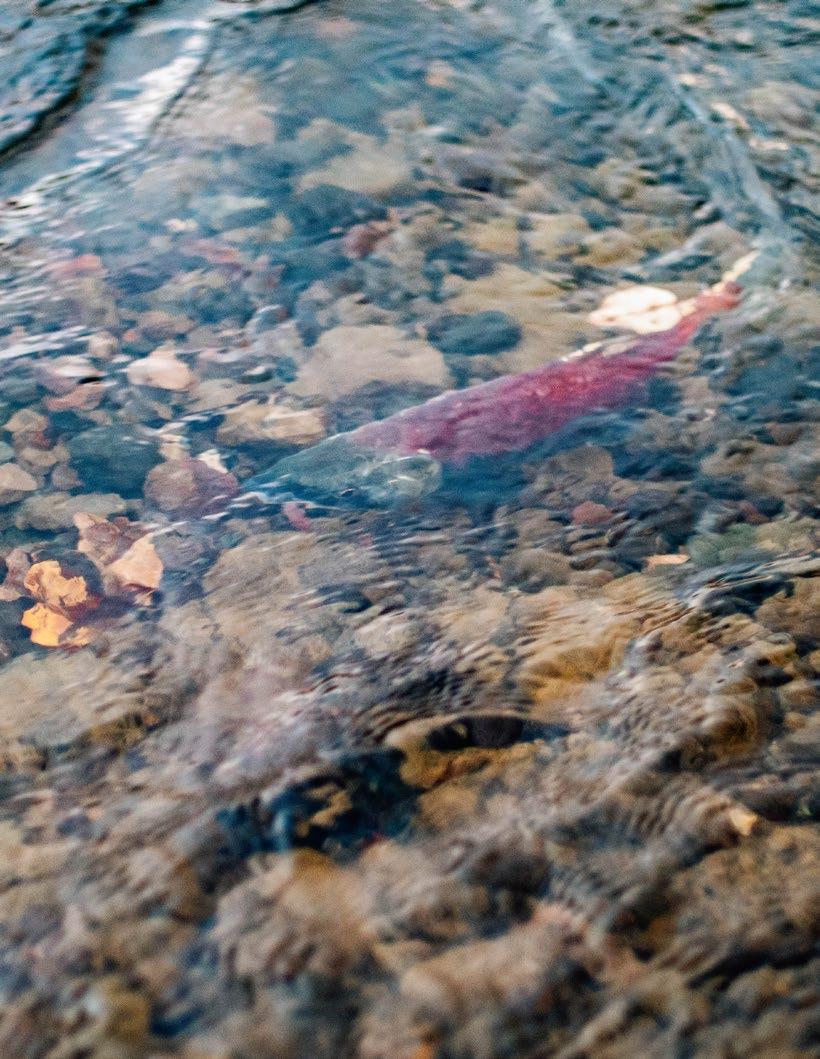
Chinook seems to be consistent with the pre-season forecast of approximately 13,400 large Chinook. This is below the escapement goal range of 14,000 to 28,000 and below the 10-year average of 17,118.
The final in-season Sockeye salmon run size estimate is approximately 60,000 to 85,000 fish (30,000 to 45,000 Tahltan origin). This is below the recent 10-year average of 114,700 Sockeye salmon and below the preseason forecast of 103,000.
Although there is a goal set out in the table of the Treaty, there continues to be no means of accurately estimating Stikine Coho escapement or run size. The work to develop an accurate estimate of Stikine Coho was started in 2019 but had to be put on hold for 2020 due to COVID-19. Hopefully, the work will be undertaken in 2021.
*Less than 100 large Chinook were of Stikine origin.
2020 STIKINE SALMON HARVESTS
FISHERY
TFN Food
CAN commercial
CAN Sport
CAN Totals
US Subsistence
US Sport
US Troll
US Gillnet
US Totals
SOCKEYE CHINOOK JACKS COHO
5423
6,188
0 389
0
0
11,611 389
1700 6
0 52 642
0
0
642
0
0 2
5,098
0
5,100
75
0
0 0 0 0
2,951 1,333* 0 43,702
4,651 1,391 0 43,777
FISHERIES-RELATED INDIGENOUS PROTECTED & CONSERVATION AREAS (IPCA) PROJECTS
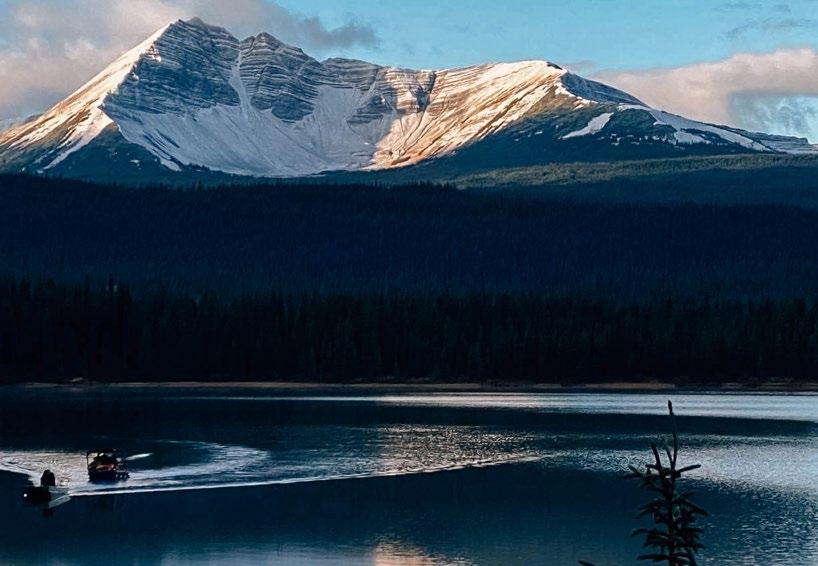
Above: IPCA – Headwaters Kluayaz Lake. This year the Tahltan Fisheries Department has been busy developing workplans and implementing new research under the IPCA / Stewardship initiative.
These projects have been designed to provide support for conservation designation by identifying critical fish habitats, characteristics, and stock status and by determining the areas and ecosystem processes that are essential for protection of the fisheries resources and associated habitats.
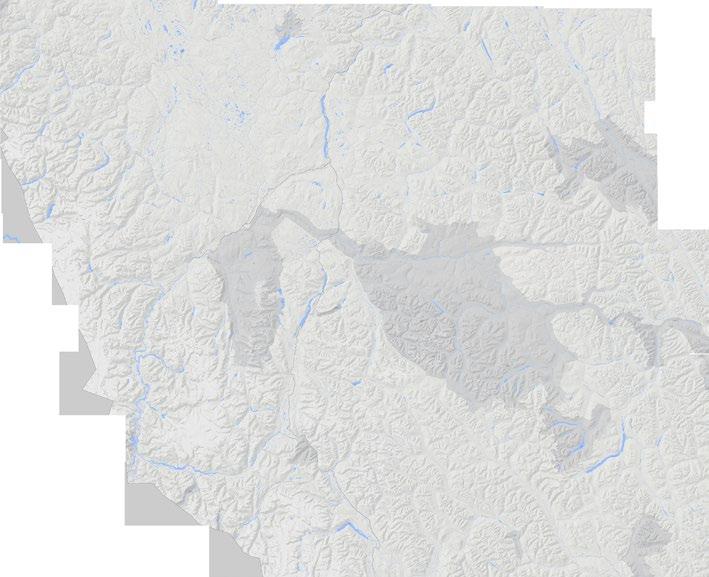
Using information collected from these activities, other important aspects can then be addressed, such as management measures, standards, regulations, and land use.
The focused fisheries areas of interest are listed below and on page 68. To note for all projects, the key field assessment tasks included hydrology i.e. flows, water quality and groundwater aspects. Bathymetric (water depth) surveys were also conducted for the lakes.
1. SHESLAY
The focus was on the Hackett River watershed. A reconnaissance field survey was done July 12 to 17. A salmon video counting system was devised, but unfortunately could not be deployed this year due to high flood river conditions.
2. HEADWATERS (OF THE SKEENA, STIKINE, & NASS):
Field surveys were conducted along the rail grade September 23 to 28. From September 29 to October 6, field work was done at Kluayaz Lake and the upper Kluatantan River watershed.
3. TAHLTAN LAKE
Field surveys were conducted from August 29 to September 5. With this project, we are also seeking to address the recent lower wild sockeye egg-to-fry survivals and aspects relating to improving passage /weir operations for the pending replacement of the dam at the outlet of the lake.
Below: IPCA – Lower Iskut Bug Lake.
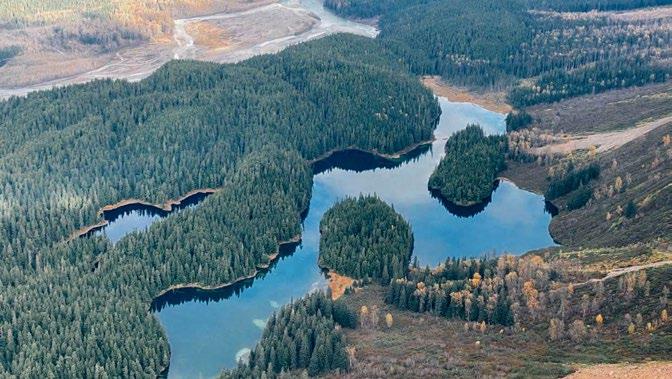
4. LITTLE TAHLTAN WATERSHED
A field survey was implemented July 18 to 21.
5. LOWER ISKUT WATERSHED:
Field surveys were conducted July 6 to 9 and October 9 to 12. The focus is on continuation of the sockeye enhancement feasibility study we have been working on.
Thanks to our dedicated field staff which included: Sheldon Dennis, John Nole, Drew Inkster, Patrick Hudson, and Richard Erhardt.
We would also like to acknowledge several folks who helped us with equipment or camp use. They include: Sheslay River Outfitters (Rudy Day) for use of their 4-wheeler at Hackett River, Lonesome Mountain Outfitters (Mike Young) for use of their camp and boat at Kluayaz Lake, and use of the camps at both Little Tahltan River and Tahltan Lake. Mēduh.
1
DEASE LAKE
SHESLAY
4
LITTLE TAHLTAN WATERSHED
3
TAHLTAN LAKE
TELEGRAPH CREEK STIKINE RIVER
EDDONTENAJON LAKE ISKUT
TATOGGA LAKE
KINASKAN LAKE
I N E RIVE R K I T S
5
LOWER ISKUT WATERSHED
ISKUT RIVER
Map 3 – IPCA Projects.
R E V I R
T U IS K
HEADWATERS KLUAYAZ LAKE
HEADWATERS – UPPER KLUATANTAN RIVER
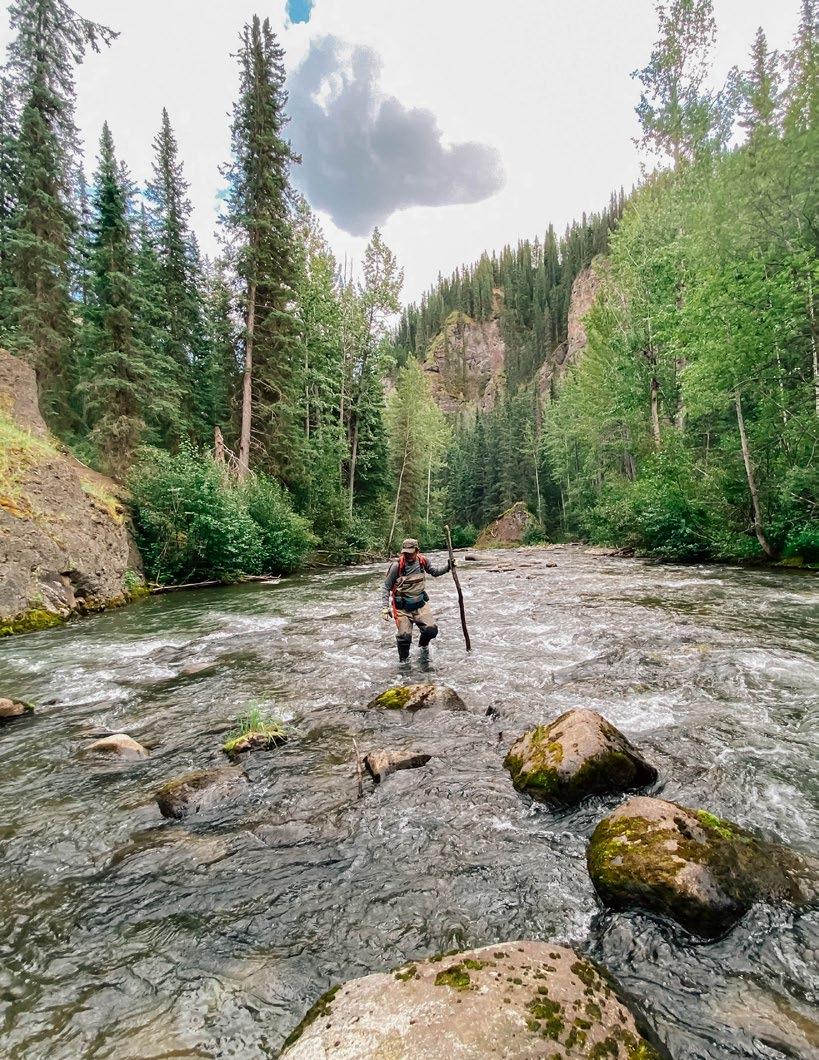
DFO Real Properties
– Facility Upgrades
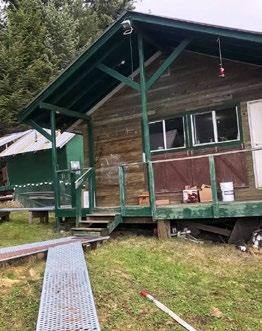
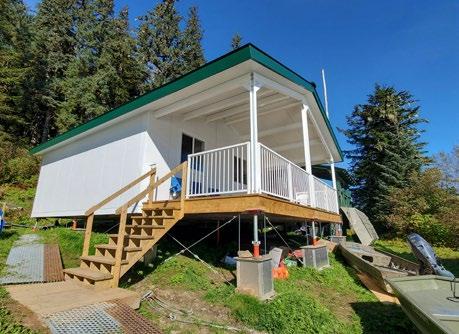
Facility upgrades and improvements to the remote DFO field camps has been ongoing since 2015. There are still ongoing discussions regarding replacement of the failing dam at Tahltan Lake and we are optimistic these works will commence soon.
The 2020 field season saw some great improvements to camp facilities at Tahltan Lake, Little Tahltan and the Lower Stikine.
These included additional showers, new sleeping quarters, storage, and a new kitchen at the Lower Stikine Camp, and were greatly appreciated by staff of every agency that uses them.


Top-left: Old kitchen at Lower Stikine.
Top-right: Outside new kitchen at Lower Stikine.
Middle-right: Lower Stikine new kitchen.
Bottom-right: Lower Stikine old kitchen.
TAHLTAN LAKE EGG TAKE
(1989-2020)
Above: Kyle receiving the female holding pen. At the February pre-season session of the Transboundary Rivers Panel (TBR) of the Pacific Salmon Treaty, the 2020 Stikine Enhancement Production Plan (SEPP) was finalized, and a five million egg take target for Tahltan Lake was bilaterally agreed upon.
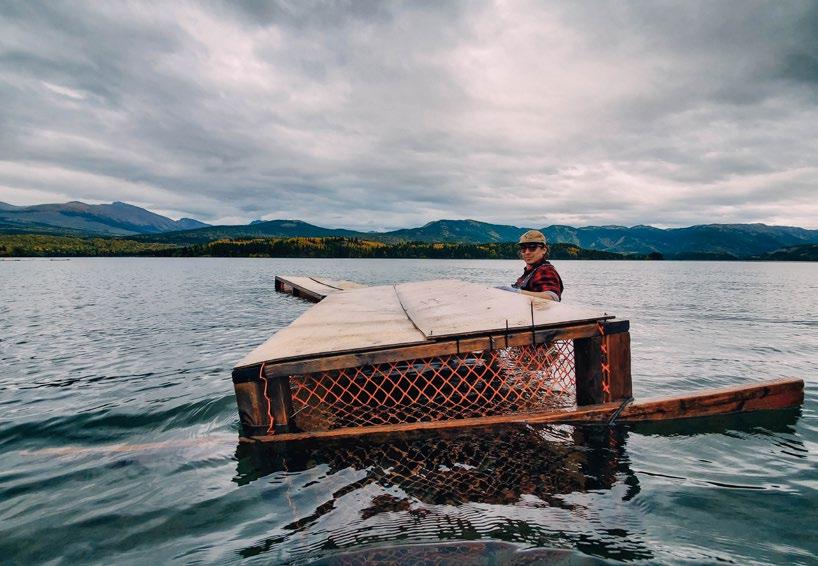
The poor wild fry survivals were also discussed and deferred to the Enhancement Sub Committee (ESC) for further review and discussion at the upcoming March Transboundary Technical Committee (TTC) pre-season meeting. One of the Alaskan panel members voiced his concern and disapproval regarding any changes being made to the target without the input and consent from the TBR Panel. Although the target is agreed upon in the SEPP at the pre-season session, the reality is the target cannot be confirmed until in-season and is dependent on spawner escapement into the lake.
The ESC met March 4 to 6 and members held a focused discussion on the poor wild smolt survivals at Tahltan Lake. After reviewing the data and recent smolt survivals, it was recommended the egg take be reduced to 2.5 million. In the months leading up to the egg take, several discussions between the TCG Fisheries Director and Sean Collins, DFO Salmonid Enhancement Program, took place to ensure the egg take target is factored using the most recent wild smolt survivals as a guideline. Follow up discussions with Alaskan representatives were held to provide rationale for the reduction and reach agreement on what is best for the Tahltan Lake sockeye stocks. After running the numbers, Sean Collins arrived at a very conservative revised egg take target of 500,000 eggs, based on the smolt data, as well as the low escapement this year. The TCGFD field crew was deployed to Tahltan Lake on September 5th with a crew from BC, Yukon, and Dease Lake. The crew collected brood stock September 7 and 11. Beach seining efforts resulted in the capture of 542 females (ripe and green) and 1,019 males. A total of 186 females and 192 males were spawned over the course of two egg takes, which were completed September 10 and 12. A total of 502,200 fertilized sockeye eggs were delivered to Port Snettisham Hatchery by Ward Air Juneau.
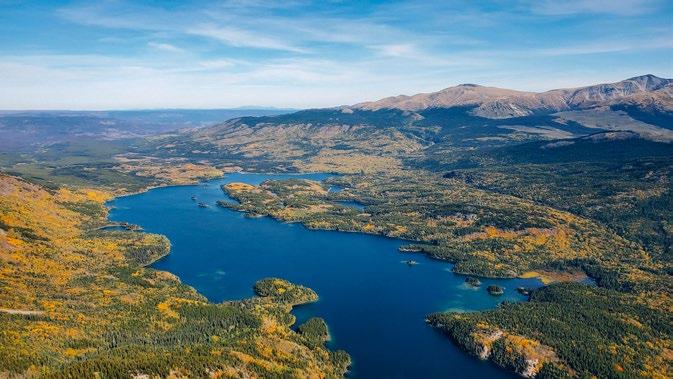
The egg take crew also delivered 20 female ovarian and kidney samples for disease testing for Infectious Heamatopoetic Necrosis Virus (IHNV) and Bacterial Kidney Disease (BKD). As well, 98 otoliths, post-orbital hypural lengths, and fork lengths were collected from both male and female brood stock, per the contract requirements. The camp was demobilized, and all crew flown out, on Sept 16.
Crew members were Richard Erhardt, Cheri Frocklage, Jared Dennis, Kyle Inkster, Drew Inkster, Kerry Carlick, Sheldon Dennis, and Michael Nole. Raina Feldman returned as our camp cook. Mēduh Raina for all the great meals and for keeping us all so well fed, despite the challenge of minimal ingredients. Thanks to the pilots and ground crew of BC Yukon Air for providing crew transport flights to this project. We also extend our gratitude to the pilots from Ward Air from Juneau for egg haul flights. We truly appreciate all the people on the other end who ensure the fuel, propane, supplies, and groceries keep coming in. We could not do it without you. A big thank you as well to DFO for use of the camp facilities.
Many thanks to our TCGFD staff for your ongoing dedication to the management of the Stikine River salmon resources. We are tremendously grateful to you all for your valuable knowledge and the time you dedicate to the field work. Your hard work never goes unnoticed. Mēduh.
BROOK STOCK COLLECTION RESULTS
542
FEMALES (Ripe & Green)
1,019
MALES
TOTAL SPAWNS OVER TWO EGG TAKES
186
FEMALES
192
MALES Above: Tahltan Lake.
Back cover: Rainbow Trout eating unviable eggs.
FERTILIZED EGG DELIVERY (Port Snettisham Hatchery by Ward Air Juneau)
502,200
SOCKEYE EGGS
Memorial Monument of Tahltan Lake
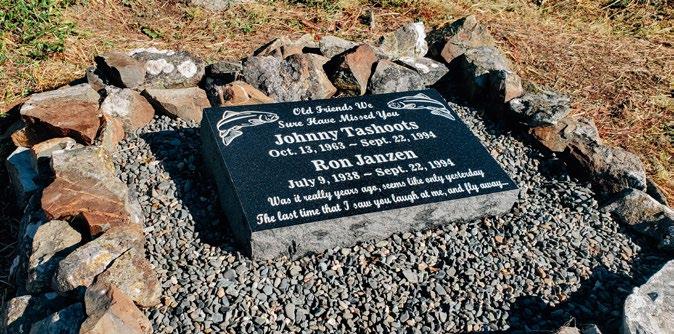
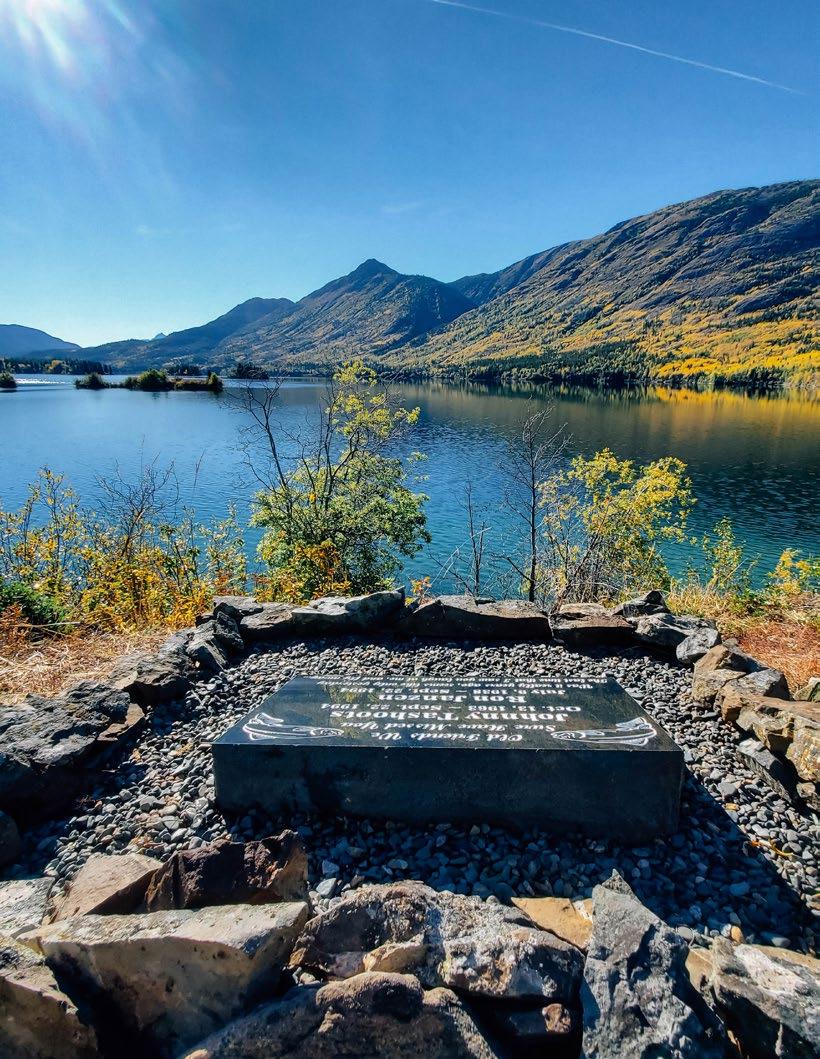
On September 22, 1994, the Tahltan Nation and our local communities suffered the heartbreak and loss of two very dear friends and colleagues. Tahltan Fisheries Technician Johnny Tashoots and Tel-Air pilot Ron Janzen lost their lives in a fatal plane crash on a return flight from delivering sockeye salmon eggs to the Port Snettisham Hatchery in Alaska.
Above and right:
Johnny Tashoots and Ron Janzen memorial at Tahltan Lake. Our Tahltan Fisheries family placed a rough marker on the point at Tahltan Lake above the main sockeye spawning grounds that served as a reminder of our lost loved ones. It was the focal point for many years of an annual bonfire and fireworks. In addition, DFO staff member Bill Waugh contacted the BC Geographical Names Office in Victoria in 1996 to officially rename the outlet creek ‘Johnny Tashoots Creek’ in his memory. The marker was replaced many times over the years, as it crumbled and eroded under the weather and elements. In the winter of 2019, Cheri decided it was time a formal monument be established to commemorate the lives of these fine men for their ultimate sacrifice.
On September 14 of this year, this idea became reality with the design, labour and support from the egg take crew. I cannot express my level of gratitude to my staff. There are no words to describe my feelings, as through my tears, I watched them carry the heavy stone from the boat, up the steep rock face of the point and to its final place of rest. My staff, many of whom did not know either Johnny or Ron, did not hesitate to assist in the efforts to honour these men. They may not have met them, but they know they were our brothers and members of this large extended family we all belong to.
The monument is beautiful. The view is breathtaking and befitting for our fallen comrades. From my heart to you, my sincere thanks for your act of kindness. I remain eternally grateful to you all.
Northern Fund
2020
Below: Johnny Tashoots Creek. Bottom-left: Clements Brace on Beaver removal.
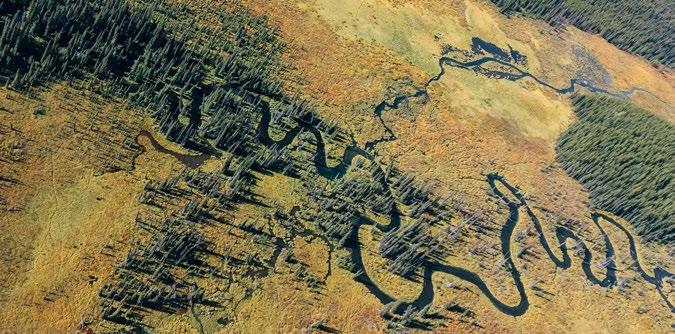
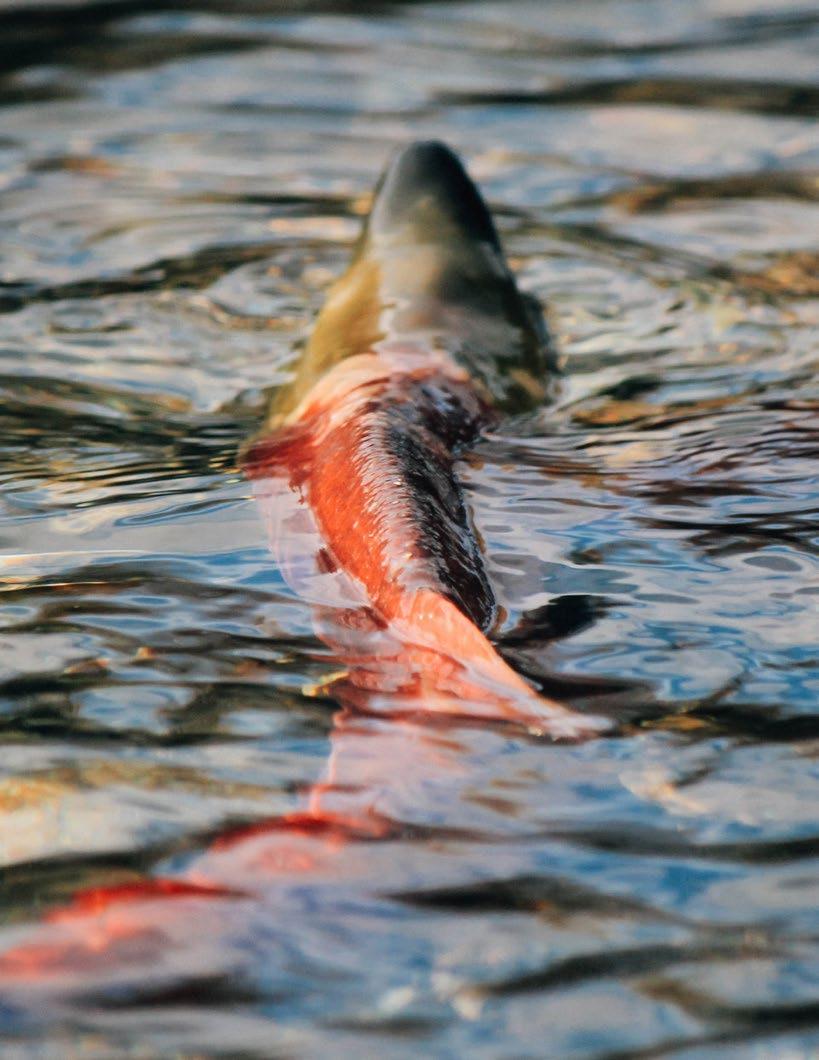
TCGFD was able to successfully secure $43,817 from the PSC Northern Endowment Fund to conduct the Tahltan Lake Sockeye Access Improvement and Trail Clearing project from August 3 to 13, 2020.
This was a combined submission to address and control the beaver population, remove any dams in JT Creek that may block migration of returning sockeye adults or out migrating smolts, as well as improve access to these sites. It will also ensure the safety of the staff who walk the creek to remove any dams in season that may create challenges for salmon passage.
As in 2019, TCG Fisheries Department field technician and beaver guru John Nole teamed up with the TCG Guardian Clements Brace to complete the beaver portion of the work. They removed eight beavers and three dams. Due to the higher water conditions, they did not have to work as fervently as usual to keep up with the breaching of dams. The beaver damming activity was minimal with the improved water flows in JT Creek at the time of the project. Drew Inkster and Mitchell Engdahl conducted trail cutting and clearing to widen and open the trail, which has been neglected for quite some time. Crew members using the trail now will find it clear of debris. It will also minimize the opportunity for chance encounters with grizzly bears, who travel the creek and trail in search of a sockeye meal.
Many thanks to the crew members for their hard work and completion of these important tasks. Mēduh.
The 2021 proposal submission to the Northern Fund to conduct spring juvenile studies at the Hackett River has been denied funding and TCGFD will be seeking alternate funding sources to pursue this project.
FISHERIES DEPARTMENT Staff Bios
Margaret Asp
My Name is Margaret Asp. I am the daughter of the late Ray and Ann Henyu. I started work for Tahltan Fisheries over 10 years ago as a Chinook sampler and was promoted to the Guardian position and stationed at Tahltan ever since. I love working with my co-workers every summer and always look forward to starting each year.
Jared Dennis
I am of Tlingit/Tahltan blood and from the Wolf clan. I have been with Tahltan Fisheries since I turned 18 in 2005 when, at the end of my grade 11 school year, I was asked to go to Tahltan Lake. Following my grade 12 school year, I returned to Tahltan Fisheries to continue my employment.
I love the outdoors, our Tahltan country, learning more about our fish and wildlife, and using all the skills my grandparents taught me about loving and respecting the fish, wildlife, and land. I have been to every camp that fisheries has offered, from the lower end of the Stikine on the Alaskan side, where the salmon first enter, to their spawning grounds: Iskut, Tuya, Tahltan, Little Tahltan Rivers, where some of the chinook spawn, and Tahltan Lake, where sockeye spawn. One year I got to tag an adult chinook on the Alaska side, then observed it arrive at the Little Tahltan River, where their long journey ends. Every summer, I am either camping or at fish camp with my grandparents. I recall the first time I saw a salmon at Spencer Flats and didn’t know what type of fish it was, because all I knew was a fish was a fish. Now I know all types of fish and, this year, how far they can travel.
Sheldon Steven Dennis
My name is Sheldon Steven Dennis. I come from the Wolf clan and Simgaltada family. I started working with Tahltan Fisheries in the summer of 1997 and have been with them ever since. I grew up in Iskut and moved to Terrace in 2004.
In 2004, I graduated from the Freda Diesing School of Northwest Coast Arts, completing a two-year course. I have been working out at Tahltan Lake since 1997 on the Sockeye smolt program and the Sockeye Adult program. In 2010 I started doing the Little Tahltan River Chinook Weir and in 2017 we started using a video counter at Little Tahltan. I also do the egg take program at Tahltan Lake. I am now doing little projects along the Iskut River and up at the Sacred Headwaters. In 2021, I will be helping set up a camera counter out at the Hackett River.
Richard Erhardt
Hons. BSc.
Richard has been providing technical support to Tahltan Fisheries as a contract biologist since 2003. In that time, he has helped facilitate the expansion of their involvement in fisheries management and has promoted continuous program development. Most of the projects or forums he assists with come from additional proposal-based funding.
Richard has expedited many new fisheries projects in a wide variety of categories, including stock assessment, enhancement, lake surveys, habitat mapping, environmental assessment, strategic planning, and community education. He also provides support by attending key meetings such as the TBR PSC Technical Committee and Panel. Richard is now the project biologist for the Tahltan Lake egg take project and currently is largely focused on assisting with the fisheries related IPCA projects.
Raïna Feldman
My name is Raïna Feldman. I work for the Tahltan Fisheries Program as a Fisheries Technician and as a Camp Cook. I am also the Level 3 First Aid Attendant for our crew. My parents are Patricia McIntosh and Richard Feldman, and my stepfather, Edward Frank, who raised me. I have lived within Tahltan Territory most of my life, growing up in Telegraph Creek, raising my three children in Iskut and Dease Lake, and now residing in Dease Lake.
I begin the season working on the Coded Wire Tagging Program on the Lower Stikine in the early Spring. I do the Upper River Sampling Program in Telegraph Creek all Summer, then move to Tahltan Lake for the egg take for the Fall. I am grateful every day to be working in some of the most beautiful places in the world and with an amazing crew that is like family.
Patrick Hudson
Patrick is a hydrologist and fisheries scientist who has worked for Tahltan Fisheries and the Lands Department for 15 years. Prior to working for Tahltan Fisheries, Patrick was the BC Ministry of Environment Regional Hydrologist for the Skeena Region, where he focused on hydrometric standards and environmental impact assessments of regional projects including Tahltan Territory industrial proposals.
Much of his previous work with THREAT and the Lands Department have involved the review of industrial projects such as Red Chris and Seabridge Gold’s KSM Project. With these reviews and site inspections he has focused on environmental impact assessment, monitoring and water management as priorities. Most recently Patrick is working on the IPCA planning studies with a focus on fisheries capacity building and conservation planning across Tahltan Territory.
Drew Inkster
I am the youngest of Christine and Greg Inskter’s four children. I am from the Wolf clan and belong to the Cawtoonma family. I was born and raised in Terrace, but very much enjoy every chance to come back to our Tahltan Territory. I have worked for Tahltan Fisheries for the better part of a decade and have been to many different work sites doing various projects. I have primarily been on the Stikine doing the Adult Chinook Tagging project with my brother, Kyle Inkster. I also work at the Little Tahltan and Tahltan Lake projects and some other smaller projects. When I am not at work, I enjoy riding my ATV, fishing, hunting, barbequing, hockey, and spending time with my family. I am very excited to continue working with fisheries at our new home with TCG.
Kyle Inkster
My name is Kyle Inkster. I am from the Cawtoonma family. I have worked as a Fisheries Technician/Supervisor for Tahltan Fisheries since 2008, mostly down river on the Lower Stikine, Chinook Tagging Program. I was born and raised in Terrace. My parents are Greg and Christine Inkster, who both grew up in Telegraph Creek. My father was born there. When I am not working, I am working on art, music, and skateboarding.
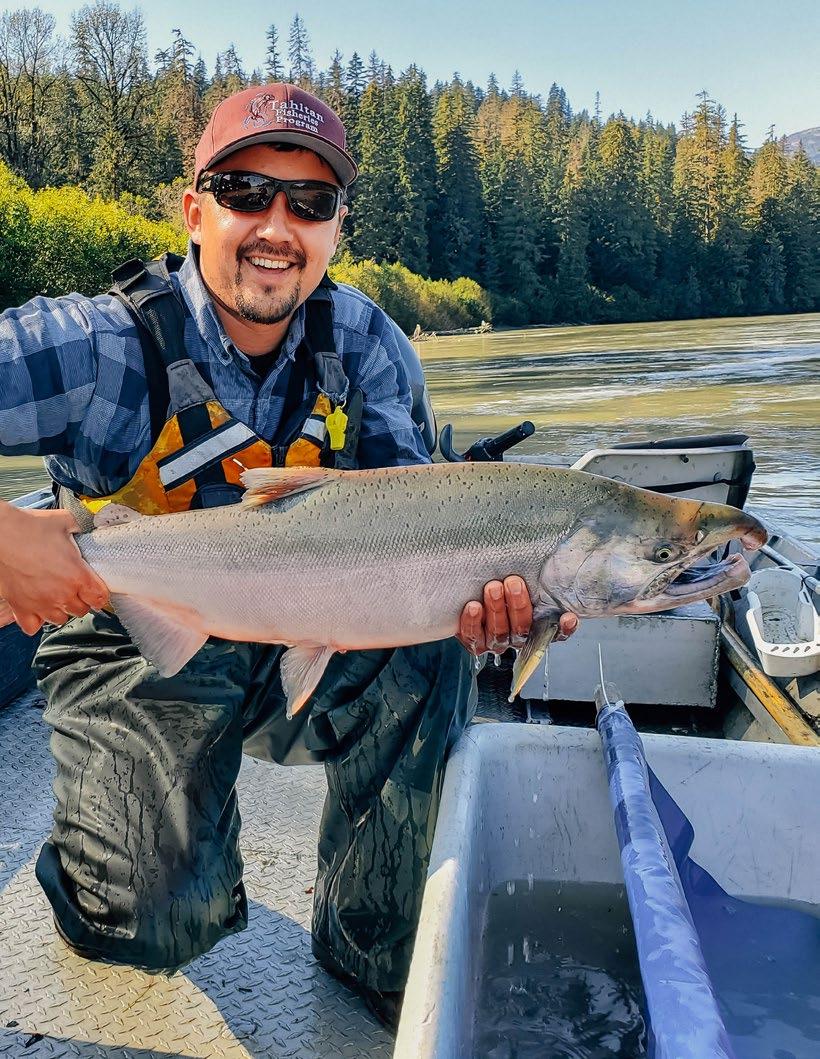
Brendan Joseph
My name is Brendan Joseph. I am son to Floyd and Karen Joseph, and grandson to Alex and Rachel Joseph. This year was my first year with Tahltan Fisheries. I worked on the upper river project where we sampled sockeye and chinook salmon. Sampling consists of collecting data such as weights, lengths, scale samples, and egg diameters.
John Nole
My name is John Nole and I have worked for Tahltan Fisheries for several years. My job takes me places where our Ancestors lived off the land. My work consists of seining (small mesh netting) smolts on the Lower Stikine, the Tahltan Lake egg take, doing alternate fishing for brood stock collection, and beaver dam breaching (so the salmon can make it back to Tahltan Lake). I also do some field work with our hydrologist. I like my job because it takes me out on the land our Ancestors left in trust to us for our future generations. Mēduh.
Noreen McLean (Vance)
My name is Noreen McLean, and I am from the Tahltan Nation, born and raised in Telegraph Creek. I am the daughter of Henry and Janet Vance and I am Crow clan, which I inherited from my mother. I spent my entire childhood, as well as my young adulthood, learning the traditions of my people. I spent many seasons with my mother and grandmother, Fannie Woods, learning the skills of fishing, gutting, smoking, preparing, and harvesting salmon for the colder months.
Now, as an adult, I have a seasonal job with the Fisheries Department, where I have been working for 13 years. I love my job! My title is Catch Monitor and my duties include issuing fishing and transport permits to Tahltan people and to provide them a daily catch calendar to keep track of their harvest numbers. I routinely visit fish camps and collect weekly data. I enjoy working with the TCG Fisheries Department because it allows me to return home every summer and do what I love. Namely, I am honoured to carry on the heritage of my Elders and their Ancestors before them. I have extreme gratitude for the work I do and the people I work with; I would not trade it for anything in this world!
Michael Nole
My Name Is Michael Nole and I am from the Wolf clan. I was born and raised in Iskut. My parents are the late Loveman and Sara Nole. My dad’s parents were Bell and Ester Nole. My mom’s parents were Kishkosh and Sophie Tashoots. I am proud to say I have a beautiful family with my wife Mary, three stepdaughters and three precious granddaughters.
I have been working for Tahltan Fisheries for 17 years. I work in three different camps: Tahltan Lake, Little Tahltan River, and the Lower Stikine. The past few seasons, I have also trained a few new TCG staff and DFO personnel as well. I really enjoy passing on the knowledge I have learned through the years with Tahltan Fisheries.
I recently graduated with a Dogwood diploma. It was on my bucket list and I did it! A big thanks goes out to Lax Kw’alaams Academy for giving me a chance to do it. I am looking forward to continuing working with and taking on the new challenges TCG has to offer.










